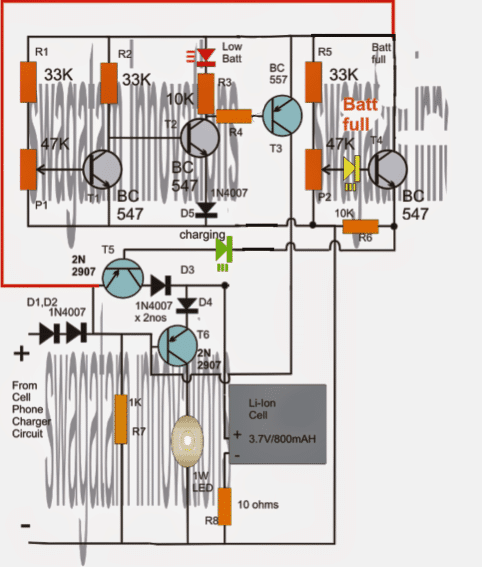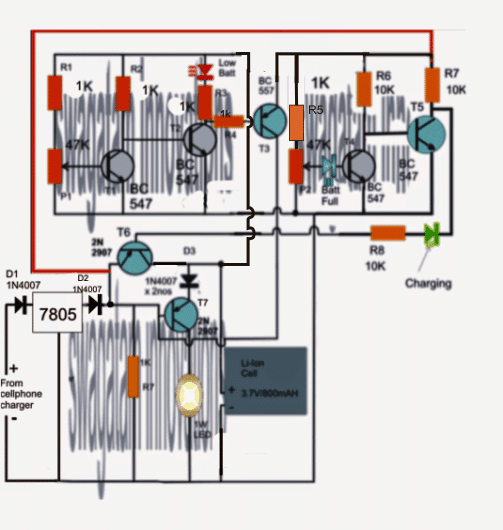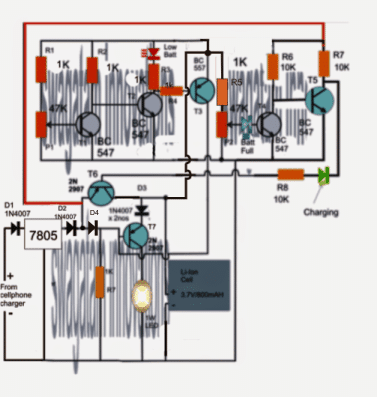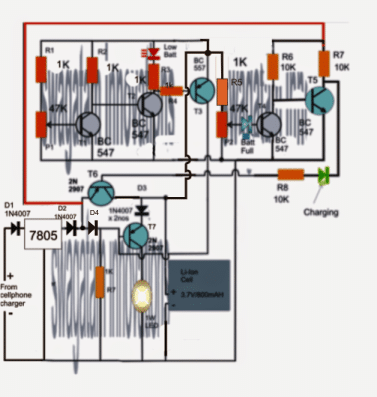The post presents a simple Li-ion emergency light circuit with over charge and low battery cut off features. The Circuit was requested by Mr. Saeed Abu and Y0f4N.
Technical Requirement
Bro thanks for ur reply. Actually im Pharmacist(M.Pharm) & Electronics is my hobby. So i go through ur mentioned link & i dont understand ur suggestion to modify that diagram also about ur mentioned cut off transistor. So would u mind to send me the complete circuit diagram
My requirement is:(1) Circuit is Operated by Nokia standard cell phone charger
(2) Battery nokia 3.7 volt
(3) Auto ac to dc changeover system when ac fail
(4) Battery overcharge protection system(auto battery full charge cutoff) with LED indicator.I have tried many times to develop such type of circuit but i failed. So Please bro help me urgently. Please design it simple.
The Design
The proposed Li-ion emergency light circuit with over charge and low battery cut off features functioning may be understood with the the following points:
Transistor T6 is basically configured to automatically sense and shut off the LED during the presence of mains AC and vice versa. Here a mobile charger is used for powering the T6 circuit.
As long as the mains input is available, the 1 watt LED stays switched OFF due to the presence of a positive potential at the base of T6, T6 starts conducting the moment AC mains fails illuminating the connected LED with the help of the attached Li-ion battery power.
T1 and T2 form the low battery detector stage and does the same when the Li-ion battery voltage falls below a certain predetermined level set by P1.
When this happens, T1 just stops conducting forcing T2, T3 to switch ON hard.
T3 passes the battery voltage to the base of T6 choking its conduction thereby shutting off the LED and inhibiting any further loss of voltage under the situation.
T4 and T5 are configured for the opposite function, that is for detecting the full charge of the li-ion battery.
P2 is appropriately set such that T4 conducts fully at this battery voltage.
With T4 fully ON, the base of T5 is unable to acquire the required negative biasing via R6 and thus is prevented from supplying the charging voltage to the battery, which in turn protects the battery from getting over charged and damaged in due course of time.
The red/green LEDs indicate the relevant states of the battery and the cut off conditions.

The 10 ohm with the negative of the battery may be eliminated, it's not worth with so many existing protections.
For getting a better response from the over-charge cut-off stage, the above circuit could be modified further with an additional transistor stage T5, as shown below:
Referring to the following circuit, we are able to the see a few crucial additions and removals:
IC 7805 has been added, diode at T6 collector is removed, and D1 position changed. These changes ensure that an exact 4.3V is able to develop across the emitter of T6 and ground, irrespective of the input voltage level.
D5 has been removed in order to provide a better illumination for the LED at the collector of T2.
All high value resistors have now been reduced to 1K for an increased current biasing for the BJTs.

As suggested by one of the avid readers of this blog Mr. Syed, the above diagram needed some corrections.
The finalized diagram of the Li-ion emergency light circuit with over charge and low battery cut off featurescan be seen below:

